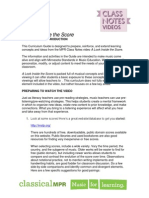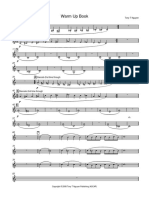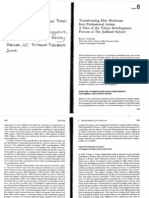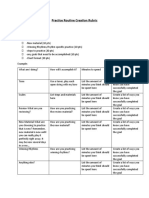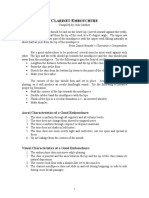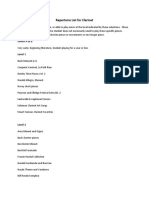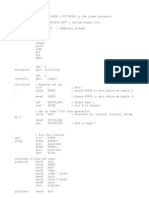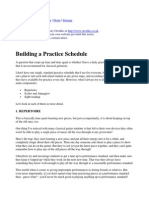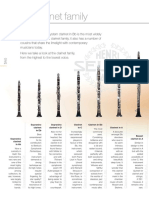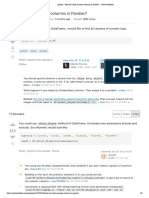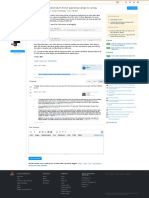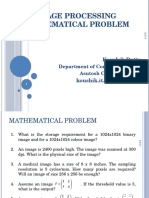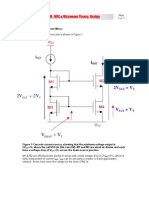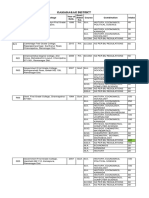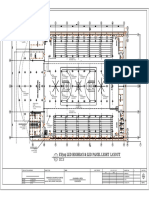Sorting Arrays in VBA
Uploaded by
vaskoreSorting Arrays in VBA
Uploaded by
vaskoreAdvanced Software Pearson Software Consulting Office Integration Projects
NET Programming
www.cpearson.com [email protected] XML Development
Design And Development
Search The Site: Search
Home Topic Index What's New Search
Consulting Downloads Feedback Contact
-->
Sorting Array In VBA
This page describes procedures for sorting arrays of values in VBA.
Introduction
The VBA language has no support for sorting the values stored in an array. One method that can be used to sort
arrays is to put the data on to a worksheet, sort the data on the worksheet, and then read back the values from
the worksheet into the array. The other method for sorting arrays is to use the QSort algorithm to sort the array in
place. This page describes both methods, with variations on the QSort method.
Sorting Via Worksheet
This section describes code that uses Excel's range sorting method to sort the values in an array. The code first
creates a new worksheet so that this code won't clash with existing data on a worksheet. Then, it loads the
values in the array to a range on the new worksheet, begining in cell A1. That range is sorted and the data is
read back into the array in VBA. The code for SortViaWorksheet is shown below.
Sub SortViaWorksheet()
Dim Arr(1 To 5) As String ' this is the array to be sorted
Dim WS As Worksheet ' temporary worksheet
Dim R As Range
Dim N As Long
' fill up the array with some
' aribtrary values.
Arr(1) = "aaa"
Arr(2) = "zzz"
Arr(3) = "mmm"
Arr(4) = "ttt"
Arr(5) = "bbb"
Application.ScreenUpdating = False
' create a new sheet
Set WS = ThisWorkbook.Worksheets.Add
' put the array values on the worksheet
Set R = WS.Range("A1").Resize(UBound(Arr) - LBound(Arr) + 1, 1)
R = Application.Transpose(Arr)
' sort the range
R.Sort key1:=R, order1:=xlAscending, MatchCase:=False
' load the worksheet values back into the array
For N = 1 To R.Rows.Count
Arr(N) = R(N, 1)
Next N
' delete the temporary sheet
Application.DisplayAlerts = False
WS.Delete
Application.DisplayAlerts = True
Application.ScreenUpdating = True
' test/debug/confirmation
For N = LBound(Arr) To UBound(Arr)
Debug.Print Arr(N)
Next N
End Sub
The SortViaWorksheet function works if you are using Excel and the structure of the workbook is not
protected. It the workbook is protected, you'll get an error when creating the new sheet, so you will have to have
a scratch sheet in place beforehand or use an unused region of an existing (and unprotected) worksheet. Due to
these limitations, coupled with the fact that VBA is used in many applications other than Excel, it may be
desirable to employ a VBA-only method that doesn't rely on any outside objects.
Sorting by any method is an expensive operations, especially with large arrays, due to the number of swaps
made during the sorting process. Before sorting a large array, it might be useful to test whether the array is
already in sorted order and thus does not need to be sorted. Procedures for testing if an array is sorted can be
found on the IsArraySorted page.
Sorting With VBA Code
The code below in a implementation of the QSort algorithm for sorting an array. It will work with array that contain
either numeric or string values. The input array is sorted in place. That means that after the procedure has
ended, the original array will have been modified and sorted. The QSortInPlace and related procedures will
sort an array of numeric or string values in either ascending or descending order. The declaration for
QSortInPlace is shown below:
Public Function QSortInPlace( _
ByRef InputArray As Variant, _
Optional ByVal LB As Long = -1&, _
Optional ByVal UB As Long = -1&, _
Optional ByVal Descending As Boolean = False, _
Optional ByVal CompareMode As VbCompareMethod = vbTextCompare, _
Optional ByVal NoAlerts As Boolean = False) As Boolean
InputArray is the array to be sorted. LB is the first element of the input array to sort. A value of -1 indicates to
start sorting with the first element. UB is the last element of the input array to sort. A value of -1 indicates to sort
to the end of the array. By modifying the values of LB and UB, you can sort only a subset of the array.
Descending, if False or omitted, causes the sort to progress in ascending order. If Descending is True, the
array is sorted in descending order. CompareMode indicates whether the sorting is case sensitive or case
insensitive. NoAlerts if True, supresses error messages that may occur. The function returns True if the sort
was successful or False if an error occurred. There are several procedures that support the QSortInPlace
function, so you should import the entire module into your project.
The Code
The code for QSortInPlace and supporting procedures is shown below:
Public Function QSortInPlace( _
ByRef InputArray As Variant, _
Optional ByVal LB As Long = -1&, _
Optional ByVal UB As Long = -1&, _
Optional ByVal Descending As Boolean = False, _
Optional ByVal CompareMode As VbCompareMethod = vbTextCompare, _
Optional ByVal NoAlerts As Boolean = False) As Boolean
'''''''''''''''''''''''''''''''''''''''''''''''''''''''''''''''''''''''''''''''''''''''''''''''
' QSortInPlace
'
' This function sorts the array InputArray in place -- this is, the original array in the
' calling procedure is sorted. It will work with either string data or numeric data.
' It need not sort the entire array. You can sort only part of the array by setting the LB and
' UB parameters to the first (LB) and last (UB) element indexes that you want to sort.
' LB and UB are optional parameters. If omitted LB is set to the LBound of InputArray, and if
' omitted UB is set to the UBound of the InputArray. If you want to sort the entire array,
' omit the LB and UB parameters, or set both to -1, or set LB = LBound(InputArray) and set
' UB to UBound(InputArray).
'
' By default, the sort method is case INSENSTIVE (case doens't matter: "A", "b", "C", "d").
' To make it case SENSITIVE (case matters: "A" "C" "b" "d"), set the CompareMode argument
' to vbBinaryCompare (=0). If Compare mode is omitted or is any value other than vbBinaryCompare,
' it is assumed to be vbTextCompare and the sorting is done case INSENSITIVE.
'
' The function returns TRUE if the array was successfully sorted or FALSE if an error
' occurred. If an error occurs (e.g., LB > UB), a message box indicating the error is
' displayed. To suppress message boxes, set the NoAlerts parameter to TRUE.
'
''''''''''''''''''''''''''''''''''''''
' MODIFYING THIS CODE:
''''''''''''''''''''''''''''''''''''''
' If you modify this code and you call "Exit Procedure", you MUST decrment the RecursionLevel
' variable. E.g.,
' If SomethingThatCausesAnExit Then
' RecursionLevel = RecursionLevel - 1
' Exit Function
' End If
'''''''''''''''''''''''''''''''''''''''
'
' Note: If you coerce InputArray to a ByVal argument, QSortInPlace will not be
' able to reference the InputArray in the calling procedure and the array will
' not be sorted.
'
' This function uses the following procedures. These are declared as Private procedures
' at the end of this module:
' IsArrayAllocated
' IsSimpleDataType
' IsSimpleNumericType
' QSortCompare
' NumberOfArrayDimensions
' ReverseArrayInPlace
'
'''''''''''''''''''''''''''''''''''''''''''''''''''''''''''''''''''''''''''''''''''''''''''''''
Dim Temp As Variant
Dim Buffer As Variant
Dim CurLow As Long
Dim CurHigh As Long
Dim CurMidpoint As Long
Dim Ndx As Long
Dim pCompareMode As VbCompareMethod
'''''''''''''''''''''''''
' Set the default result.
'''''''''''''''''''''''''
QSortInPlace = False
''''''''''''''''''''''''''''''''''''''''''''''''''''''''
' This variable is used to determine the level
' of recursion (the function calling itself).
' RecursionLevel is incremented when this procedure
' is called, either initially by a calling procedure
' or recursively by itself. The variable is decremented
' when the procedure exits. We do the input parameter
' validation only when RecursionLevel is 1 (when
' the function is called by another function, not
' when it is called recursively).
''''''''''''''''''''''''''''''''''''''''''''''''''''''''
Static RecursionLevel As Long
''''''''''''''''''''''''''''''''''''''''''''''''''''''''''
' Keep track of the recursion level -- that is, how many
' times the procedure has called itself.
' Carry out the validation routines only when this
' procedure is first called. Don't run the
' validations on a recursive call to the
' procedure.
''''''''''''''''''''''''''''''''''''''''''''''''''''''''''
RecursionLevel = RecursionLevel + 1
If RecursionLevel = 1 Then
''''''''''''''''''''''''''''''''''
' Ensure InputArray is an array.
''''''''''''''''''''''''''''''''''
If IsArray(InputArray) = False Then
If NoAlerts = False Then
MsgBox "The InputArray parameter is not an array."
End If
'''''''''''''''''''''''''''''''''''''''''''''''''''''''
' InputArray is not an array. Exit with a False result.
'''''''''''''''''''''''''''''''''''''''''''''''''''''''
RecursionLevel = RecursionLevel - 1
Exit Function
End If
''''''''''''''''''''''''''''''''''''''''''''''''''''''''''
' Test LB and UB. If < 0 then set to LBound and UBound
' of the InputArray.
''''''''''''''''''''''''''''''''''''''''''''''''''''''''''
If LB < 0 Then
LB = LBound(InputArray)
End If
If UB < 0 Then
UB = UBound(InputArray)
End If
Select Case NumberOfArrayDimensions(InputArray)
Case 0
''''''''''''''''''''''''''''''''''''''''''
' Zero dimensions indicates an unallocated
' dynamic array.
''''''''''''''''''''''''''''''''''''''''''
If NoAlerts = False Then
MsgBox "The InputArray is an empty, unallocated array."
End If
RecursionLevel = RecursionLevel - 1
Exit Function
Case 1
''''''''''''''''''''''''''''''''''''''''''
' We sort ONLY single dimensional arrays.
''''''''''''''''''''''''''''''''''''''''''
Case Else
''''''''''''''''''''''''''''''''''''''''''
' We sort ONLY single dimensional arrays.
''''''''''''''''''''''''''''''''''''''''''
If NoAlerts = False Then
MsgBox "The InputArray is multi-dimensional." & _
"QSortInPlace works only on single-dimensional arrays."
End If
RecursionLevel = RecursionLevel - 1
Exit Function
End Select
'''''''''''''''''''''''''''''''''''''''''''''''''''
' Ensure that InputArray is an array of simple data
' types, not other arrays or objects. This tests
' the data type of only the first element of
' InputArray. If InputArray is an array of Variants,
' subsequent data types may not be simple data types
' (e.g., they may be objects or other arrays), and
' this may cause QSortInPlace to fail on the StrComp
' operation.
'''''''''''''''''''''''''''''''''''''''''''''''''''
If IsSimpleDataType(InputArray(LBound(InputArray))) = False Then
If NoAlerts = False Then
MsgBox "InputArray is not an array of simple data types."
RecursionLevel = RecursionLevel - 1
Exit Function
End If
End If
''''''''''''''''''''''''''''''''''''''''''''''''''''
' ensure that the LB parameter is valid.
''''''''''''''''''''''''''''''''''''''''''''''''''''
Select Case LB
Case Is < LBound(InputArray)
If NoAlerts = False Then
MsgBox "The LB lower bound parameter is less than the LBound of the InputArray"
End If
RecursionLevel = RecursionLevel - 1
Exit Function
Case Is > UBound(InputArray)
If NoAlerts = False Then
MsgBox "The LB lower bound parameter is greater than the UBound of the InputArray"
End If
RecursionLevel = RecursionLevel - 1
Exit Function
Case Is > UB
If NoAlerts = False Then
MsgBox "The LB lower bound parameter is greater than the UB upper bound parameter."
End If
RecursionLevel = RecursionLevel - 1
Exit Function
End Select
''''''''''''''''''''''''''''''''''''''''''''''''''''
' ensure the UB parameter is valid.
''''''''''''''''''''''''''''''''''''''''''''''''''''
Select Case UB
Case Is > UBound(InputArray)
If NoAlerts = False Then
MsgBox "The UB upper bound parameter is greater than the upper bound of the InputArray."
End If
RecursionLevel = RecursionLevel - 1
Exit Function
Case Is < LBound(InputArray)
If NoAlerts = False Then
MsgBox "The UB upper bound parameter is less than the lower bound of the InputArray."
End If
RecursionLevel = RecursionLevel - 1
Exit Function
Case Is < LB
If NoAlerts = False Then
MsgBox "the UB upper bound parameter is less than the LB lower bound parameter."
End If
RecursionLevel = RecursionLevel - 1
Exit Function
End Select
''''''''''''''''''''''''''''''''''''''''''''''''''''''
' if UB = LB, we have nothing to sort, so get out.
''''''''''''''''''''''''''''''''''''''''''''''''''''''
If UB = LB Then
QSortInPlace = True
RecursionLevel = RecursionLevel - 1
Exit Function
End If
End If ' RecursionLevel = 1
''''''''''''''''''''''''''''''''''''''''''''''''''''''''''
' Ensure that CompareMode is either vbBinaryCompare or
' vbTextCompare. If it is neither, default to vbTextCompare.
''''''''''''''''''''''''''''''''''''''''''''''''''''''''''
If (CompareMode = vbBinaryCompare) Or (CompareMode = vbTextCompare) Then
pCompareMode = CompareMode
Else
pCompareMode = vbTextCompare
End If
''''''''''''''''''''''''''''''''''''''''''''''''''''''''''''
' Begin the actual sorting process.
''''''''''''''''''''''''''''''''''''''''''''''''''''''''''''
CurLow = LB
CurHigh = UB
If LB = 0 Then
CurMidpoint = ((LB + UB) \ 2) + 1
Else
CurMidpoint = (LB + UB) \ 2 ' note integer division (\) here
End If
Temp = InputArray(CurMidpoint)
Do While (CurLow <= CurHigh)
Do While QSortCompare(V1:=InputArray(CurLow), V2:=Temp, CompareMode:=pCompareMode) < 0
CurLow = CurLow + 1
If CurLow = UB Then
Exit Do
End If
Loop
Do While QSortCompare(V1:=Temp, V2:=InputArray(CurHigh), CompareMode:=pCompareMode) < 0
CurHigh = CurHigh - 1
If CurHigh = LB Then
Exit Do
End If
Loop
If (CurLow <= CurHigh) Then
Buffer = InputArray(CurLow)
InputArray(CurLow) = InputArray(CurHigh)
InputArray(CurHigh) = Buffer
CurLow = CurLow + 1
CurHigh = CurHigh - 1
End If
Loop
If LB < CurHigh Then
QSortInPlace InputArray:=InputArray, LB:=LB, UB:=CurHigh, _
Descending:=Descending, CompareMode:=pCompareMode, NoAlerts:=True
End If
If CurLow < UB Then
QSortInPlace InputArray:=InputArray, LB:=CurLow, UB:=UB, _
Descending:=Descending, CompareMode:=pCompareMode, NoAlerts:=True
End If
'''''''''''''''''''''''''''''''''''''
' If Descending is True, reverse the
' order of the array, but only if the
' recursion level is 1.
'''''''''''''''''''''''''''''''''''''
If Descending = True Then
If RecursionLevel = 1 Then
ReverseArrayInPlace2 InputArray, LB, UB
End If
End If
RecursionLevel = RecursionLevel - 1
QSortInPlace = True
End Function
Public Function QSortCompare(V1 As Variant, V2 As Variant, _
Optional CompareMode As VbCompareMethod = vbTextCompare) As Long
'''''''''''''''''''''''''''''''''''''''''''''''''''''''''''''''''''
' QSortCompare
' This function is used in QSortInPlace to compare two elements. If
' V1 AND V2 are both numeric data types (integer, long, single, double)
' they are converted to Doubles and compared. If V1 and V2 are BOTH strings
' that contain numeric data, they are converted to Doubles and compared.
' If either V1 or V2 is a string and does NOT contain numeric data, both
' V1 and V2 are converted to Strings and compared with StrComp.
'
' The result is -1 if V1 < V2,
' 0 if V1 = V2
' 1 if V1 > V2
' For text comparisons, case sensitivity is controlled by CompareMode.
' If this is vbBinaryCompare, the result is case SENSITIVE. If this
' is omitted or any other value, the result is case INSENSITIVE.
'
'''''''''''''''''''''''''''''''''''''''''''''''''''''''''''''''''''
Dim D1 As Double
Dim D2 As Double
Dim S1 As String
Dim S2 As String
Dim Compare As VbCompareMethod
''''''''''''''''''''''''''''''''''''''''''''''''
' Test CompareMode. Any value other than
' vbBinaryCompare will default to vbTextCompare.
''''''''''''''''''''''''''''''''''''''''''''''''
If CompareMode = vbBinaryCompare Or CompareMode = vbTextCompare Then
Compare = CompareMode
Else
Compare = vbTextCompare
End If
'''''''''''''''''''''''''''''''''''''''''''''''
' If either V1 or V2 is either an array or
' an Object, raise a error 13 - Type Mismatch.
'''''''''''''''''''''''''''''''''''''''''''''''
If IsArray(V1) = True Or IsArray(V2) = True Then
Err.Raise 13
Exit Function
End If
If IsObject(V1) = True Or IsObject(V2) = True Then
Err.Raise 13
Exit Function
End If
If IsSimpleNumericType(V1) = True Then
If IsSimpleNumericType(V2) = True Then
'''''''''''''''''''''''''''''''''''''
' If BOTH V1 and V2 are numeric data
' types, then convert to Doubles and
' do an arithmetic compare and
' return the result.
'''''''''''''''''''''''''''''''''''''
D1 = CDbl(V1)
D2 = CDbl(V2)
If D1 = D2 Then
QSortCompare = 0
Exit Function
End If
If D1 < D2 Then
QSortCompare = -1
Exit Function
End If
If D1 > D2 Then
QSortCompare = 1
Exit Function
End If
End If
End If
''''''''''''''''''''''''''''''''''''''''''''
' Either V1 or V2 was not numeric data type.
' Test whether BOTH V1 AND V2 are numeric
' strings. If BOTH are numeric, convert to
' Doubles and do a arithmetic comparison.
''''''''''''''''''''''''''''''''''''''''''''
If IsNumeric(V1) = True And IsNumeric(V2) = True Then
D1 = CDbl(V1)
D2 = CDbl(V2)
If D1 = D2 Then
QSortCompare = 0
Exit Function
End If
If D1 < D2 Then
QSortCompare = -1
Exit Function
End If
If D1 > D2 Then
QSortCompare = 1
Exit Function
End If
End If
''''''''''''''''''''''''''''''''''''''''''''''
' Either or both V1 and V2 was not numeric
' string. In this case, convert to Strings
' and use StrComp to compare.
''''''''''''''''''''''''''''''''''''''''''''''
S1 = CStr(V1)
S2 = CStr(V2)
QSortCompare = StrComp(S1, S2, Compare)
End Function
Public Function NumberOfArrayDimensions(Arr As Variant) As Integer
''''''''''''''''''''''''''''''''''''''''''''''''''''''''''''''''''''''''''''''''''''''''''''''''''''
' NumberOfArrayDimensions
' This function returns the number of dimensions of an array. An unallocated dynamic array
' has 0 dimensions. This condition can also be tested with IsArrayEmpty.
'''''''''''''''''''''''''''''''''''''''''''''''''''''''''''''''''''''''''''''''''''''''''''''''''''''
Dim Ndx As Integer
Dim Res As Integer
On Error Resume Next
' Loop, increasing the dimension index Ndx, until an error occurs.
' An error will occur when Ndx exceeds the number of dimension
' in the array. Return Ndx - 1.
Do
Ndx = Ndx + 1
Res = UBound(Arr, Ndx)
Loop Until Err.Number <> 0
NumberOfArrayDimensions = Ndx - 1
End Function
Public Function ReverseArrayInPlace(InputArray As Variant, _
Optional NoAlerts As Boolean = False) As Boolean
''''''''''''''''''''''''''''''''''''''''''''''''''''''''''''''''''''''''''''''''''''''''''''
' ReverseArrayInPlace
' This procedure reverses the order of an array in place -- this is, the array variable
' in the calling procedure is sorted. An error will occur if InputArray is not an array,
'if it is an empty, unallocated array, or if the number of dimensions is not 1.
'
' NOTE: Before calling the ReverseArrayInPlace procedure, consider if your needs can
' be met by simply reading the existing array in reverse order (Step -1). If so, you can save
' the overhead added to your application by calling this function.
'
' The function returns TRUE if the array was successfully reversed, or FALSE if
' an error occurred.
'
' If an error occurred, a message box is displayed indicating the error. To suppress
' the message box and simply return FALSE, set the NoAlerts parameter to TRUE.
'
'''''''''''''''''''''''''''''''''''''''''''''''''''''''''''''''''''''''''''''''''''''''''''''
Dim Temp As Variant
Dim Ndx As Long
Dim Ndx2 As Long
Dim OrigN As Long
Dim NewN As Long
Dim NewArr() As Variant
''''''''''''''''''''''''''''''''
' Set the default return value.
''''''''''''''''''''''''''''''''
ReverseArrayInPlace = False
'''''''''''''''''''''''''''''''''
' Ensure we have an array
'''''''''''''''''''''''''''''''''
If IsArray(InputArray) = False Then
If NoAlerts = False Then
MsgBox "The InputArray parameter is not an array."
End If
Exit Function
End If
''''''''''''''''''''''''''''''''''''''
' Test the number of dimensions of the
' InputArray. If 0, we have an empty,
' unallocated array. Get out with
' an error message. If greater than
' one, we have a multi-dimensional
' array, which is not allowed. Only
' an allocated 1-dimensional array is
' allowed.
''''''''''''''''''''''''''''''''''''''
Select Case NumberOfArrayDimensions(InputArray)
Case 0
'''''''''''''''''''''''''''''''''''''''''''
' Zero dimensions indicates an unallocated
' dynamic array.
'''''''''''''''''''''''''''''''''''''''''''
If NoAlerts = False Then
MsgBox "The input array is an empty, unallocated array."
End If
Exit Function
Case 1
'''''''''''''''''''''''''''''''''''''''''''
' We can reverse ONLY a single dimensional
' arrray.
'''''''''''''''''''''''''''''''''''''''''''
Case Else
'''''''''''''''''''''''''''''''''''''''''''
' We can reverse ONLY a single dimensional
' arrray.
'''''''''''''''''''''''''''''''''''''''''''
If NoAlerts = False Then
MsgBox "The input array multi-dimensional. ReverseArrayInPlace works only " & _
"on single-dimensional arrays."
End If
Exit Function
End Select
'''''''''''''''''''''''''''''''''''''''''''''
' Ensure that we have only simple data types,
' not an array of objects or arrays.
'''''''''''''''''''''''''''''''''''''''''''''
If IsSimpleDataType(InputArray(LBound(InputArray))) = False Then
If NoAlerts = False Then
MsgBox "The input array contains arrays, objects, or other complex data types." & vbCrLf & _
"ReverseArrayInPlace can reverse only arrays of simple data types."
Exit Function
End If
End If
ReDim NewArr(LBound(InputArray) To UBound(InputArray))
NewN = UBound(NewArr)
For OrigN = LBound(InputArray) To UBound(InputArray)
NewArr(NewN) = InputArray(OrigN)
NewN = NewN - 1
Next OrigN
For NewN = LBound(NewArr) To UBound(NewArr)
InputArray(NewN) = NewArr(NewN)
Next NewN
ReverseArrayInPlace = True
End Function
Public Function ReverseArrayInPlace2(InputArray As Variant, _
Optional LB As Long = -1, Optional UB As Long = -1, _
Optional NoAlerts As Boolean = False) As Boolean
''''''''''''''''''''''''''''''''''''''''''''''''''''''''''''''''''''''''''''''''''''''''''''
' ReverseArrayInPlace2
' This reverses the order of elements in InputArray. To reverse the entire array, omit or
' set to less than 0 the LB and UB parameters. To reverse only part of tbe array, set LB and/or
' UB to the LBound and UBound of the sub array to be reversed.
''''''''''''''''''''''''''''''''''''''''''''''''''''''''''''''''''''''''''''''''''''''''''''
Dim N As Long
Dim Temp As Variant
Dim Ndx As Long
Dim Ndx2 As Long
Dim OrigN As Long
Dim NewN As Long
Dim NewArr() As Variant
''''''''''''''''''''''''''''''''
' Set the default return value.
''''''''''''''''''''''''''''''''
ReverseArrayInPlace2 = False
'''''''''''''''''''''''''''''''''
' Ensure we have an array
'''''''''''''''''''''''''''''''''
If IsArray(InputArray) = False Then
If NoAlerts = False Then
MsgBox "The InputArray parameter is not an array."
End If
Exit Function
End If
''''''''''''''''''''''''''''''''''''''
' Test the number of dimensions of the
' InputArray. If 0, we have an empty,
' unallocated array. Get out with
' an error message. If greater than
' one, we have a multi-dimensional
' array, which is not allowed. Only
' an allocated 1-dimensional array is
' allowed.
''''''''''''''''''''''''''''''''''''''
Select Case NumberOfArrayDimensions(InputArray)
Case 0
'''''''''''''''''''''''''''''''''''''''''''
' Zero dimensions indicates an unallocated
' dynamic array.
'''''''''''''''''''''''''''''''''''''''''''
If NoAlerts = False Then
MsgBox "The input array is an empty, unallocated array."
End If
Exit Function
Case 1
'''''''''''''''''''''''''''''''''''''''''''
' We can reverse ONLY a single dimensional
' arrray.
'''''''''''''''''''''''''''''''''''''''''''
Case Else
'''''''''''''''''''''''''''''''''''''''''''
' We can reverse ONLY a single dimensional
' arrray.
'''''''''''''''''''''''''''''''''''''''''''
If NoAlerts = False Then
MsgBox "The input array multi-dimensional. ReverseArrayInPlace works only " & _
"on single-dimensional arrays."
End If
Exit Function
End Select
'''''''''''''''''''''''''''''''''''''''''''''
' Ensure that we have only simple data types,
' not an array of objects or arrays.
'''''''''''''''''''''''''''''''''''''''''''''
If IsSimpleDataType(InputArray(LBound(InputArray))) = False Then
If NoAlerts = False Then
MsgBox "The input array contains arrays, objects, or other complex data types." & vbCrLf & _
"ReverseArrayInPlace can reverse only arrays of simple data types."
Exit Function
End If
End If
If LB < 0 Then
LB = LBound(InputArray)
End If
If UB < 0 Then
UB = UBound(InputArray)
End If
For N = LB To (LB + ((UB - LB - 1) \ 2))
Temp = InputArray(N)
InputArray(N) = InputArray(UB - (N - LB))
InputArray(UB - (N - LB)) = Temp
Next N
ReverseArrayInPlace2 = True
End Function
Public Function IsSimpleNumericType(V As Variant) As Boolean
''''''''''''''''''''''''''''''''''''''''''''''''''''''''''''''''
' IsSimpleNumericType
' This returns TRUE if V is one of the following data types:
' vbBoolean
' vbByte
' vbCurrency
' vbDate
' vbDecimal
' vbDouble
' vbInteger
' vbLong
' vbSingle
' vbVariant if it contains a numeric value
' It returns FALSE for any other data type, including any array
' or vbEmpty.
''''''''''''''''''''''''''''''''''''''''''''''''''''''''''''''''
If IsSimpleDataType(V) = True Then
Select Case VarType(V)
Case vbBoolean, _
vbByte, _
vbCurrency, _
vbDate, _
vbDecimal, _
vbDouble, _
vbInteger, _
vbLong, _
vbSingle
IsSimpleNumericType = True
Case vbVariant
If IsNumeric(V) = True Then
IsSimpleNumericType = True
Else
IsSimpleNumericType = False
End If
Case Else
IsSimpleNumericType = False
End Select
Else
IsSimpleNumericType = False
End If
End Function
Public Function IsSimpleDataType(V As Variant) As Boolean
''''''''''''''''''''''''''''''''''''''''''''''''''''''''''
' IsSimpleDataType
' This function returns TRUE if V is one of the following
' variable types (as returned by the VarType function:
' vbBoolean
' vbByte
' vbCurrency
' vbDate
' vbDecimal
' vbDouble
' vbEmpty
' vbError
' vbInteger
' vbLong
' vbNull
' vbSingle
' vbString
' vbVariant
'
' It returns FALSE if V is any one of the following variable
' types:
' vbArray
' vbDataObject
' vbObject
' vbUserDefinedType
' or if it is an array of any type.
''''''''''''''''''''''''''''''''''''''''''''''''''''''''''
On Error Resume Next
''''''''''''''''''''''''''''''''''''''''''''''''''''''''''''''''''
' Test if V is an array. We can't just use VarType(V) = vbArray
' because the VarType of an array is vbArray + VarType(type
' of array element). E.g, the VarType of an Array of Longs is
' 8195 = vbArray + vbLong.
''''''''''''''''''''''''''''''''''''''''''''''''''''''''''''''''''
If IsArray(V) = True Then
IsSimpleDataType = False
Exit Function
End If
''''''''''''''''''''''''''''''''''''''''''''''''''''''''''''''''''
' We must also explicitly check whether V is an object, rather
' relying on VarType(V) to equal vbObject. The reason is that
' if V is an object and that object has a default proprety, VarType
' returns the data type of the default property. For example, if
' V is an Excel.Range object pointing to cell A1, and A1 contains
' 12345, VarType(V) would return vbDouble, the since Value is
' the default property of an Excel.Range object and the default
' numeric type of Value in Excel is Double. Thus, in order to
' prevent this type of behavior with default properties, we test
' IsObject(V) to see if V is an object.
''''''''''''''''''''''''''''''''''''''''''''''''''''''''''''''''''
If IsObject(V) = True Then
IsSimpleDataType = False
Exit Function
End If
'''''''''''''''''''''''''''''''''''''
' Test the value returned by VarType.
'''''''''''''''''''''''''''''''''''''
Select Case VarType(V)
Case vbArray, vbDataObject, vbObject, vbUserDefinedType
'''''''''''''''''''''''
' not simple data types
'''''''''''''''''''''''
IsSimpleDataType = False
Case Else
''''''''''''''''''''''''''''''''''''
' otherwise it is a simple data type
''''''''''''''''''''''''''''''''''''
IsSimpleDataType = True
End Select
End Function
Public Function IsArrayAllocated(Arr As Variant) As Boolean
''''''''''''''''''''''''''''''''''''''''''''''''''''''''''''''''''''''''''''''''''''''''''''''''''
' IsArrayAllocated
' Returns TRUE if the array is allocated (either a static array or a dynamic array that has been
' sized with Redim) or FALSE if the array has not been allocated (a dynamic that has not yet
' been sized with Redim, or a dynamic array that has been Erased).
''''''''''''''''''''''''''''''''''''''''''''''''''''''''''''''''''''''''''''''''''''''''''''''''''
Dim N As Long
'''''''''''''''''''''''''''''''''''''''''''''''''''
' If Arr is not an array, return FALSE and get out.
'''''''''''''''''''''''''''''''''''''''''''''''''''
If IsArray(Arr) = False Then
IsArrayAllocated = False
Exit Function
End If
''''''''''''''''''''''''''''''''''''''''''''''''''''''''''''''''''''''''''
' Try to get the UBound of the array. If the array has not been allocated,
' an error will occur. Test Err.Number to see if an error occured.
''''''''''''''''''''''''''''''''''''''''''''''''''''''''''''''''''''''''''
On Error Resume Next
N = UBound(Arr, 1)
If Err.Number = 0 Then
'''''''''''''''''''''''''''''''''''''
' No error. Array has been allocated.
'''''''''''''''''''''''''''''''''''''
IsArrayAllocated = True
Else
'''''''''''''''''''''''''''''''''''''
' Error. Unallocated array.
'''''''''''''''''''''''''''''''''''''
IsArrayAllocated = False
End If
End Function
You can download the file with all the example code on this page.
This page last updated: 7-June-2009.
Home Topic Index What's New Search
Consulting Downloads Feedback Legal
Created By Chip Pearson at Pearson Software Consulting
This Page: www.cpearson.com/excel/SortingArrays.aspx Email: [email protected]
Last Updated: 06-May-2018 Please read this page before emailing me.
Copyright 1997 - 2014, Charles H. Pearson Phone: (816) 325-9822 USA Central Time (-6:00 UTC)
Site Last Updated: 23-Mar-2021 Between 9:00 AM and 7:00 PM
Essential Tools For Developers
The world's choice for creating NET-based Commercial Quality Add-Ins for Office
Add-In Express Is The Most Important Tool For Creating Commerical Level Components
Learn more about Excel and VBA (Visual Basic for Applications).
Cite this page as:
Source: www.cpearson.com/excel/SortingArrays.aspx Copyright 2018, Charles H. Pearson Citation Information
This site created with Microsoft Visual Studio 2013 Premium and ASP.NET 4
Advertise Your Product On This Site
You might also like
- Burns Review Dietz Teaching Woodwinds DRNo ratings yetBurns Review Dietz Teaching Woodwinds DR2 pages
- 2954 4200 00 XRYS 557-577 CD - Product ReferenceNo ratings yet2954 4200 00 XRYS 557-577 CD - Product Reference6 pages
- The Road From The BB To Eb Jorge Montilla Moreno ICANo ratings yetThe Road From The BB To Eb Jorge Montilla Moreno ICA8 pages
- Free Excel VBA Course #26 - Using Arrays in VBANo ratings yetFree Excel VBA Course #26 - Using Arrays in VBA1 page
- Brent Coppenbarger - Fine-Tuning The Clarinet Section - A Handbook For The Band Director (2015, Rowman & Littlefield Publishers) - Libgen - LiNo ratings yetBrent Coppenbarger - Fine-Tuning The Clarinet Section - A Handbook For The Band Director (2015, Rowman & Littlefield Publishers) - Libgen - Li132 pages
- F! :G "Fi : Exercises To Introduce The Altisslmo RegisterNo ratings yetF! :G "Fi : Exercises To Introduce The Altisslmo Register2 pages
- VBA Code For Charts and Graphs in Excel - Excel Off The GridNo ratings yetVBA Code For Charts and Graphs in Excel - Excel Off The Grid1 page
- Practice Routine Creation Rubric Augest 2021No ratings yetPractice Routine Creation Rubric Augest 20211 page
- Larinet Mbouchure: Aural Characteristics of A Good EmbouchureNo ratings yetLarinet Mbouchure: Aural Characteristics of A Good Embouchure2 pages
- Effective Rehearsal Techniques: Infusing Your Daily Rehearsals With Musical ConceptsNo ratings yetEffective Rehearsal Techniques: Infusing Your Daily Rehearsals With Musical Concepts7 pages
- DynastyOfBrass - Surasakmontree Brass Band PDFNo ratings yetDynastyOfBrass - Surasakmontree Brass Band PDF50 pages
- Repertoire List For Clarinet: Levels A & BNo ratings yetRepertoire List For Clarinet: Levels A & B5 pages
- TBA Journal - December 2003 Volume 5, No. 2 Clarinet Reed Preparation and Adjustment100% (1)TBA Journal - December 2003 Volume 5, No. 2 Clarinet Reed Preparation and Adjustment2 pages
- Meter Tempo Form Meter Tempo Form Meter Tempo Form Meter Tempo Form Meter Tempo FormNo ratings yetMeter Tempo Form Meter Tempo Form Meter Tempo Form Meter Tempo Form Meter Tempo Form1 page
- Financial Statement AND Ratio Analysis TablesNo ratings yetFinancial Statement AND Ratio Analysis Tables46 pages
- The Clarinet and The Italian Opera CompoNo ratings yetThe Clarinet and The Italian Opera Compo3 pages
- Learn Faster Perform Better A Musician s Guide to the Neuroscience of Practicing 1st Edition Molly Gebrian - Download the ebook now to never miss important information50% (2)Learn Faster Perform Better A Musician s Guide to the Neuroscience of Practicing 1st Edition Molly Gebrian - Download the ebook now to never miss important information71 pages
- All State Audition Requirements Rotation C 1No ratings yetAll State Audition Requirements Rotation C 19 pages
- How To Successfully Break in Clarinet ReedsNo ratings yetHow To Successfully Break in Clarinet Reeds1 page
- Benade-Woodwinds: The Evolutionary Path Since 1700No ratings yetBenade-Woodwinds: The Evolutionary Path Since 170053 pages
- Van Cott Information Services Inc Clarinet CatalogNo ratings yetVan Cott Information Services Inc Clarinet Catalog152 pages
- Narrowing The Search: Which Hyperparameters Really Matter?No ratings yetNarrowing The Search: Which Hyperparameters Really Matter?9 pages
- Python - How Do I Find Numeric Columns in Pandas - Stack OverflowNo ratings yetPython - How Do I Find Numeric Columns in Pandas - Stack Overflow6 pages
- Mboxcox, Interpreting Difficult Regressions: 2 AnswersNo ratings yetMboxcox, Interpreting Difficult Regressions: 2 Answers1 page
- Python - Display Number With Leading Zeros - Stack OverflowNo ratings yetPython - Display Number With Leading Zeros - Stack Overflow8 pages
- Organisational Restructure Excel Dashboard - Excel Dashboards VBANo ratings yetOrganisational Restructure Excel Dashboard - Excel Dashboards VBA1 page
- Three Reasons That You Should NOT Use Deep Learning - by George Seif - Towards Data ScienceNo ratings yetThree Reasons That You Should NOT Use Deep Learning - by George Seif - Towards Data Science1 page
- For-Loops in R (Optional Lab) : This Is A Bonus Lab. You Are Not Required To Know This Information For The Final ExamNo ratings yetFor-Loops in R (Optional Lab) : This Is A Bonus Lab. You Are Not Required To Know This Information For The Final Exam2 pages
- Refer To Excel Cell in Table by Header Name and Row Number: 7 AnswersNo ratings yetRefer To Excel Cell in Table by Header Name and Row Number: 7 Answers1 page
- Autofilter With Column Formatted As Date: 10 AnswersNo ratings yetAutofilter With Column Formatted As Date: 10 Answers1 page
- VBA - String Parsing. String Parsing Involves Looking Through - by Breakcorporate - MediumNo ratings yetVBA - String Parsing. String Parsing Involves Looking Through - by Breakcorporate - Medium1 page
- 3 Must-Have Projects For Your Data Science Portfolio - by Aakash N S - Jovian - Jan, 2021 - MediumNo ratings yet3 Must-Have Projects For Your Data Science Portfolio - by Aakash N S - Jovian - Jan, 2021 - Medium1 page
- Excel - Selecting A Specific Column of A Named Range For The SUMIF Function - Stack OverflowNo ratings yetExcel - Selecting A Specific Column of A Named Range For The SUMIF Function - Stack Overflow1 page
- Semi-Automated Exploratory Data Analysis (EDA) in Python - by Destin Gong - Mar, 2021 - Towards DataNo ratings yetSemi-Automated Exploratory Data Analysis (EDA) in Python - by Destin Gong - Mar, 2021 - Towards Data3 pages
- You're Not Good at Excel and You Don't Even Know It - by Breakcorporate - MediumNo ratings yetYou're Not Good at Excel and You Don't Even Know It - by Breakcorporate - Medium1 page
- VBA - Bubble Sort. A Bubble Sort Is A Technique To Order - by Breakcorporate - MediumNo ratings yetVBA - Bubble Sort. A Bubble Sort Is A Technique To Order - by Breakcorporate - Medium1 page
- TreeSheets: App Reviews, Features, Pricing & Download - AlternativeToNo ratings yetTreeSheets: App Reviews, Features, Pricing & Download - AlternativeTo1 page
- Excel VBA - Message and Input Boxes in Excel, MsgBox Function, InputBox Function, InputBox MethodNo ratings yetExcel VBA - Message and Input Boxes in Excel, MsgBox Function, InputBox Function, InputBox Method2 pages
- Excel - Can Advanced Filter Criteria Be in The VBA Rather Than A Range? - Stack OverflowNo ratings yetExcel - Can Advanced Filter Criteria Be in The VBA Rather Than A Range? - Stack Overflow1 page
- MS Excel PivotTable Deleted Items Remain - Excel and AccessNo ratings yetMS Excel PivotTable Deleted Items Remain - Excel and Access1 page
- Excel VBA Type Mismatch Error Passing Range To Array - Stack OverflowNo ratings yetExcel VBA Type Mismatch Error Passing Range To Array - Stack Overflow1 page
- Microsoft Lync Server 2013 Multitenant Pack For Partner Hosting Deployment GuideNo ratings yetMicrosoft Lync Server 2013 Multitenant Pack For Partner Hosting Deployment Guide91 pages
- Kok-Kwang Phoon, Jianye Ching - Risk and Reliability in Geotechnical Engineering-CRC Press (2015)No ratings yetKok-Kwang Phoon, Jianye Ching - Risk and Reliability in Geotechnical Engineering-CRC Press (2015)1 page
- 11 Class Pairing Scheem 2021: 1 Mcqs 1 Mcqs 1 MCQ 1 MCQ 1 Mcqs 1 MCQ 1 Mcqs 1 Mcqs 1 Mcqs 2 Mcqs 2 McqsNo ratings yet11 Class Pairing Scheem 2021: 1 Mcqs 1 Mcqs 1 MCQ 1 MCQ 1 Mcqs 1 MCQ 1 Mcqs 1 Mcqs 1 Mcqs 2 Mcqs 2 Mcqs9 pages
- Computer Fundamentals & Programming: COMSCI 1200No ratings yetComputer Fundamentals & Programming: COMSCI 120037 pages
- FINAL TECHNICAL REPORT I January 1970 To 31 March 1971 David C.F. Wu and Roger C4 RudduckNo ratings yetFINAL TECHNICAL REPORT I January 1970 To 31 March 1971 David C.F. Wu and Roger C4 Rudduck91 pages
- Ramanagar District: Sl. No. Name of The College Year of Estb. Govt./ Aided/ Pvt. Course Combination IntakeNo ratings yetRamanagar District: Sl. No. Name of The College Year of Estb. Govt./ Aided/ Pvt. Course Combination Intake5 pages
- Crouching Tigers Hidden Prey Sumatran Tiger and PRNo ratings yetCrouching Tigers Hidden Prey Sumatran Tiger and PR10 pages
- Lighting Layout: E.L. E.L. E.L. E.L. E.L. E.L. E.L. E.LNo ratings yetLighting Layout: E.L. E.L. E.L. E.L. E.L. E.L. E.L. E.L1 page


